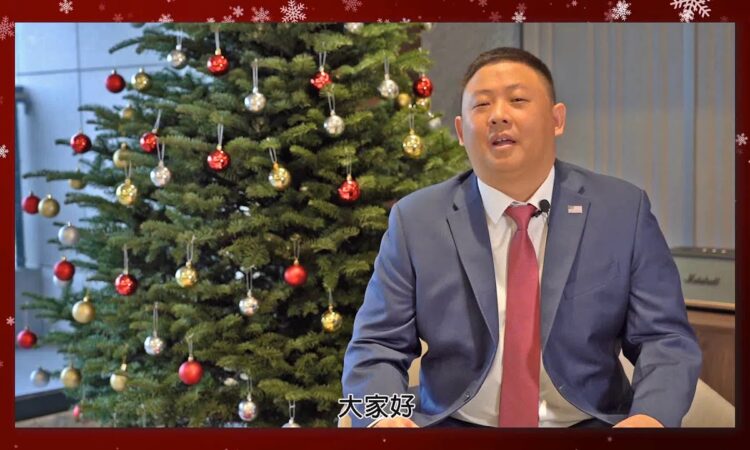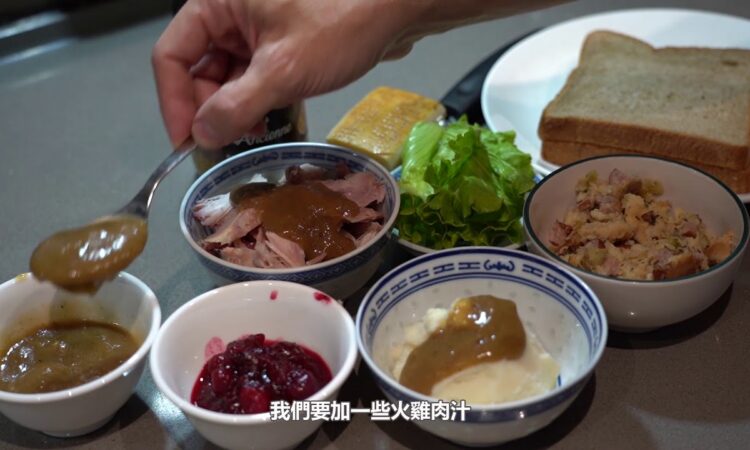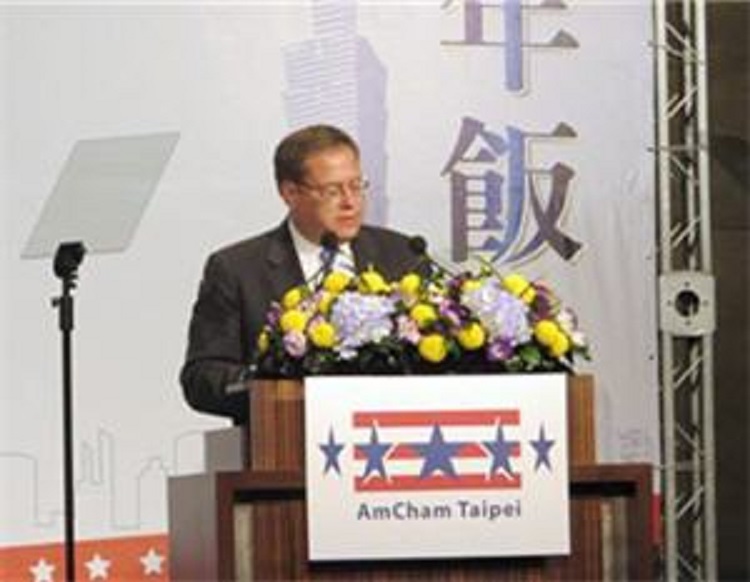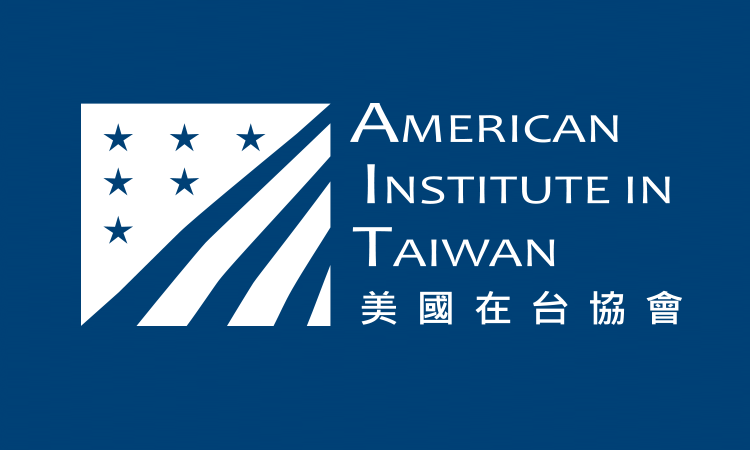Thank you, Director Moy. President Ma, Deputy Secretary-General Kao, Deputy Secretary-General Liu, Foreign Minister Lin, NDC Minister Steve Lin, Minister Deng, Minister Zhong, our gracious AmCham hosts Acting Chairperson Libby Driscoll, Vice Chairman Daniel Tseng, AmCham Taipei Chairman Dan Silver, AmCham President Andrea Wu, AmCham Board members. Thank you for the opportunity to be here. I’m delighted to be back in Taiwan. It is always a great pleasure to see the AmCham Taipei community.
At the start, I should offer congratulations to Taiwan for an election earlier this year that once again proved how Taiwan’s democracy is a model for the entire world.
In my role working on economic issues at the State Department, I’ve had a lot of opportunity lately to be thinking about Taiwan. I had the pleasure of participating in a forum earlier this month with Deputy Foreign Minister Bruce Linghu on the Global Cooperation Training Framework, or GCTF. For the United States, the GCTF is just one of many expressions of our shared values. These values as well as the economic, people-to-people, and family ties that embody them are what underpin the U.S. commitment to deepening our ties with Taiwan.
We have seen significant growth in U.S.-Taiwan ties in recent years, and are appreciative of the tremendous cooperation that Taiwan’s leaders at all levels have pursued with us. I have been fortunate to be a part of this cooperation over the years, and have engaged closely with Taiwan in many different settings.
I am now working closely with senior leadership at State, USTR, and others on challenges facing the U.S. economic policy that span the globe. This includes engaging countries such as Burma and Cuba, as they reattach to the global economy; addressing slowing growth; protecting the Internet; fostering innovation; and shaping regional economic integration.
The global economy is quickly evolving; it’s more difficult than ever for individual economies to adapt. Yet policymakers have tools to face these challenges. The United States is interested in being a constructive partner in the Asia Pacific region as we face them together.
U.S. goals and interests in the Asia-Pacific region focus on peace, stability, and a rules-based order; economic openness and sustainable development; and a steady commitment to democracy and human rights. President Obama outlined these at the U.S.-ASEAN Summit in February 15 in California. We are seeking to strengthen an international system that promotes sustainable, balanced, and inclusive growth, and which is less prone to economic crises. We want to partner with Asia, in developing solutions to important challenges in the area of energy, climate, pandemics, poverty, and the environment. We want ideas and capital to move freely to promote sustainable growth and employment. We want a “digital Asia” and an open Internet. It’s worth mentioning that the United States and Taiwan in December held our first Digital Economy Forum to improve cooperation in these and other areas.
Trade continues to play a leading role in the President’s broader economic strategy. The United States seeks to strengthen our trade relationships through a variety of bilateral, multilateral and regional trade and investment avenues, including the Trade and Investment Framework Agreements. The expansion of the Information Technology Agreement, or ITA-2, is a notable achievement, one which Taiwan, the United States, and dozens of other WTO members supported.
APEC is also a key focus of our efforts, and we envision a continued central role for APEC in promoting reform, openness and transparency. The United States and Taiwan are building on our close cooperation in APEC to conclude the Environmental Goods Agreement negotiations in the World Trade Organization. The United States seeks an ambitious and timely agreement that eliminates tariffs on a wide range of technologies – from renewables to air pollution control – urgently needed to protect our environment.
And the flagship of President Obama’s values-driven trade agenda is the TPP. By leading TPP negotiations to conclusion, the United States forged the world’s best-ever free trade agreement.
In shaping the future rules of trade, TPP is a game-changer – in its scale, in its array of improved rules for emerging trade and investment issues, and in its potential to inform global and regional trade discussions even beyond the current 12 TPP members. When the final TPP text became public in November, it prompted a lot of discussion internationally about why economies should have this kind of agreement and what it would mean for trade, workers, the environment, or human rights.
President Obama knows that TPP represents an incredible opportunity to positively shape the rules of trade in a way that promotes our interests and values — more and better growth, workers’ rights, environmental protections, transparency and fairness, and support for innovation – in a way that goes beyond any other trade agreement to date. The agreement was signed by all 12 members on February 4, and now each of the 12 members has turned to our respective domestic approval processes to ratify the agreement. In the United States, we’ll have a robust public debate about TPP, as is certainly appropriate for a trade agreement this important, but we are confident that the more people learn about what’s in TPP, the more support there will be for the agreement.
President Obama has urged Congress to vote to approve the Agreement as soon as possible, since TPP is not just hugely important for the United States, but also meets the specific negotiating objectives that Congress set forth in the Trade Promotion Authority legislation last year. At the same time that the 12 TPP partners are working on ratifying the agreement, we’re also seeing lots of work around the region by other economies considering whether they should join TPP once the agreement has entered into force. Taiwan, I am told, is undertaking its own assessment.
It’s really gratifying to see how TPP has changed the conversation on trade, in the Asia-Pacific region, and frankly around the world. That’s one of the reasons why it’s so vital that this important agreement be ratified.
You in AmCham are on the front lines of international trade, and understand what U.S. exporters and investors are up against, and how TPP can help level the playing field, expand opportunity, and raise standards. In that vein, we appreciate the efforts of the AmCham Taipei’s leadership and membership in underscoring how valuable TPP can be to your companies and to the U.S. economic presence in Asia.
Given what I’ve just said about U.S. interests in Asia, it’s appropriate to examine where Taiwan fits in. There is broad agreement in the United States, across parties and branches of government, about the critical importance of the U.S.-Taiwan relationship, and Taiwan’s valuable and beneficial role in Asia. This support is unwavering, and our policies have been and will remain consistent. We are committed to our one-China policy based on the Three Joint Communiques and the Taiwan Relations Act. We welcome and will continue to encourage cross-Strait dialogue and cooperation that promotes stability and dignity in cross-Strait relations. The United States has an enduring national interest in cross-Strait peace and stability.
Over the years, this policy has helped support the development of a strong U.S.-Taiwan economic relationship. The United States and Taiwan are each other’s second and ninth largest trading partners. This trade relationship is highly complementary. Taiwan is one of the world’s largest per capita consumers of U.S. agricultural products, for example, and is a significant consumer of U.S. intellectual property. The United States, in turn, is a destination for Taiwan’s high-tech goods and consumer electronics.
This robust economic exchange is enhanced by Taiwan’s participation in the Visa Waiver Program. In October, we celebrated Taiwan’s three-year anniversary in the program, which allows Taiwan business people and other travelers to visit the United States for business or leisure without a visa.
Beyond the shores of our two economies, we have also ramped up our cooperation on global issues, including the environment, clean energy, health, disaster relief, and humanitarian assistance. In the GCTF, which I mentioned earlier, we are jointly exploring new ways for Taiwan to provide cutting edge technical assistance to address pressing global challenges, to create opportunities for Taiwan’s engagement with counterparts in neighboring countries, and to ensure that the world has an opportunity to recognize Taiwan’s achievements. I may have flattered Taiwan in my GCTF remarks a few weeks ago, but it was fully deserved, because what I said is true: Taiwan is a responsible global citizen whose capabilities can have major impact on the region, and beyond. Taiwan’s contributions to pandemic disease preparedness, its involvement in the counter-ISIL coalition, and its leading role on climate and clean energy issues have earned the island significant dignity and respect on the world stage. And I am confident GCTF will only strengthen this trend.
We also have the U.S.-Taiwan International Environmental Partnership and the U.S.-Taiwan Digital Economy Forum, which has opened the door for our respective agencies to share ideas about how to grow digital commerce and promote our shared belief in an open, unrestricted internet. We also recently celebrated the 10-year anniversary of the launch of the COSMIC/Formosat-3 satellite constellation, built jointly by U.S. and Taiwan scientists using an advanced technology that provides invaluable weather and climate data for thousands of scientists around the world. We are jointly building a successor satellite constellation right now.
All this cooperation matters because it’s just one more illustration that Taiwan’s economy punches far above its weight, and remains internationally competitive in both business and advanced research. Now, this is admittedly not a position that will be easy for any economy to maintain. Because of globalization, staying in front of competition becomes harder as it becomes smarter, faster, and cheaper.
However, as USTR Ambassador Froman has said, globalization is a fact, not a choice; will we shape it, or be shaped by it. And so the United States and our regional partners, through TPP, are taking an active role in attempting to shape and bring order to the complexities of 21st century trade and investment. I believe that the United States and Taiwan each have new opportunities before us to shape globalization to our mutual benefit. Over the years, we have made progress in this direction through our Trade and Investment Framework Agreement discussions, known as the TIFA talks, which we most recently held in October here in Taipei, with the participation of Deputy USTR Ambassador Robert Holleyman. Some of the TIFA discussions centered on issues such as pharmaceutical patents, agricultural imports, intellectual property rights, and foreign investment. And as a result of these discussions we made some notable progress in several areas.
For Taiwan, in its present period of political transition, I believe the TIFA can serve as an impetus for us to move from simply making notable progress, to achieving important breakthroughs in the priority areas that we have jointly identified. Taiwan is also a party to the Trade in Services Agreement (TiSA) negotiations, which will encompass state-of-the-art trade rules aimed at promoting fair and open trade across the full spectrum of service sectors. Taiwan is an active partner and we look forward to working with its negotiating team to conclude TiSA in 2016.
The context of a challenged global economy presents an opportunity for Taiwan to more visibly promote its unique brand, its exceptional abilities, and its openness as an investment destination in a way that can complement its economic policy goals. The AmCham community has played an important role in zeroing-in on these opportunities and disseminating its views about how to take advantage of them. AmCham’s Annual White Paper has been a helpful tool to identify changes in the policy and regulatory environment that can improve the business climate. This year’s White Paper, I am sure, will be a particularly useful and timely guide for AmCham’s engagements with Taiwan’s newly elected officials and its regulatory authorities.
AmCham’s constructive, regular outreach to the Taiwan authorities has been and will continue to be a necessary ingredient in the smooth functioning of our prosperous trade and investment ties. I want to make sure that the AmCham members in the room know that you have my sincere appreciation for your roles in helping to build this prosperous U.S.-Taiwan relationship. In closing, I would like to underscore that in Washington, the widely held view is that U.S.-Taiwan ties have never been stronger. It’s an opinion I share. From this position of strength, the United States and Taiwan have much to look forward to in the months and years ahead: deeper discussion on pressing issues through our joint dialogues; multiple opportunities to advance our trade in goods and services, and investment; and the expansion of people-to-people ties.
This is, indeed, an extraordinary and positive moment in the history of U.S.-Taiwan ties, and I thank AmCham Taipei and Taiwan’s leaders for working with the United States to bring us to this high point. Thank you.


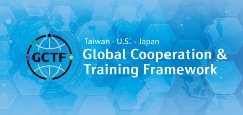




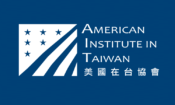
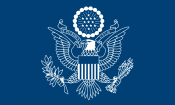
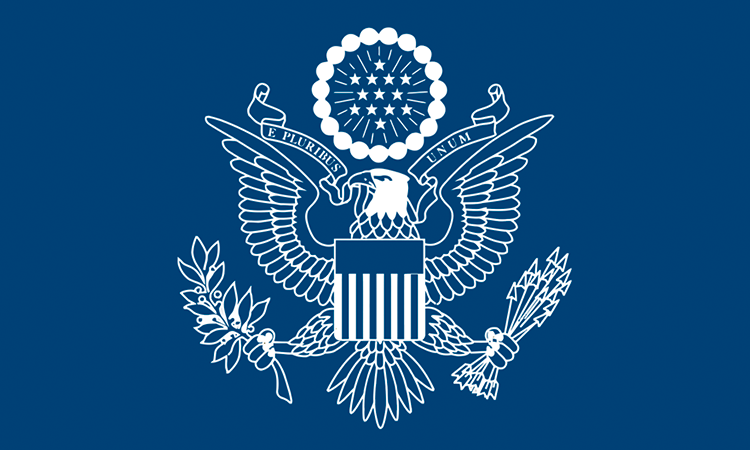




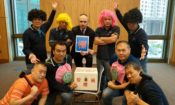
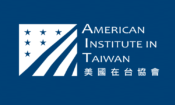
![Video Thumbnail [Recovered]-01](../wp-content/uploads/sites/269/Video-Thumbnail-Recovered-01-1-750x450.jpg)
